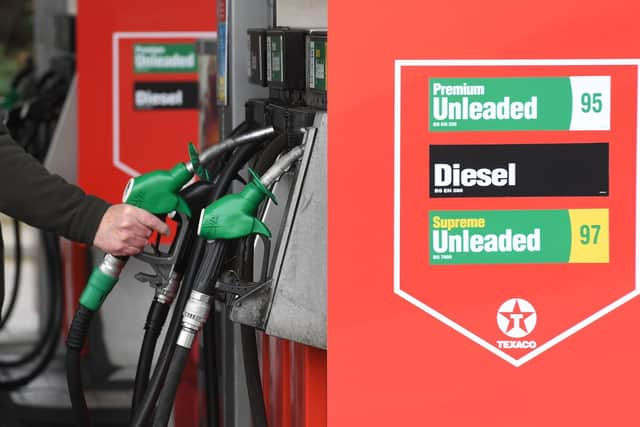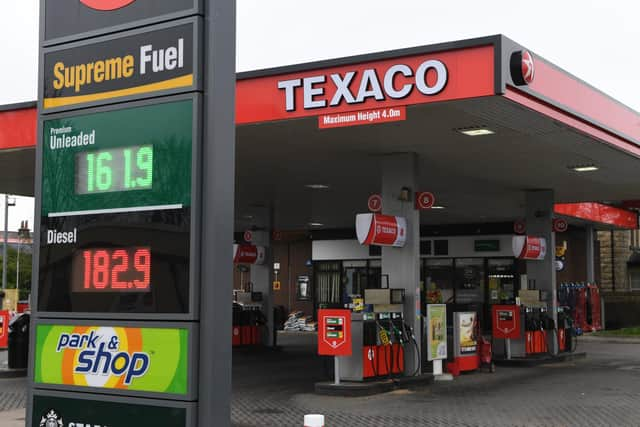COST OF LIVING CRISIS: Harrogate motorists feeling the pinch as the price of petrol hits hard
and live on Freeview channel 276
The cost of living crisis is hitting motorists hard as pump prices rose more in March than in any previous month on record - despite the Chancellor announcing that fuel duty was to be cut by 5p.
As well as hitting a new record high price of 167.3p on Tuesday, March 22, the average cost of a litre of unleaded petrol went up by a huge 11.62p to end the month at 163.28p per litre - the largest ever increase the RAC has recorded in a single month.
Advertisement
Hide AdAdvertisement
Hide AdThe impact of the almost daily price rises throughout March on drivers’ wallets was severe and it now costs nearly £90 to fill a 55-litre family petrol car, £6.38 more than it did at the start of March and £22 more than a year ago, an increase of 32%.


The effect of the rise in diesel prices is even more prominent, with the cost of a tank up by £12 in March, around £15 more than it did at the start of January and almost £28 more than a year ago, a shocking increase of 40%.
Simon Williams, from the RAC, said: “March 2022 will go down in the history books as one of the worst months ever when it comes to pump prices.
“Over the 22 years we have been monitoring pump prices as part of our Fuel Watch initiative, we’ve never witnessed such extreme rises in prices over such a short period.
Advertisement
Hide AdAdvertisement
Hide Ad“To describe the current situation facing drivers at the forecourt as ‘bleak’ is therefore something of an understatement.


“Without question, these figures show in the starkest possible terms just how much fuel prices are contributing to the cost of living crisis which will be affecting households up and down the country.
“We know that so many drivers depend on their vehicles - for instance, because of a lack of feasible alternatives - so fuel prices must be starting to have an enormously detrimental effect on people’s finances, especially those on lower incomes.”
COST OF LIVING CRISIS: Charities and support groups across Harrogate district offering vital help for those who are struggling
Advertisement
Hide AdAdvertisement
Hide AdThe impact of rising fuel prices is already being felt across the Harrogate district with many businesses facing tough times ahead.
Driving instructors are feeling the pinch, with many already having increased the price of their lessons following the Covid-19 pandemic as they struggle to make up for lost earnings and deal with a huge demand for learners.
Stuart Winder, a driving instructor who offers lessons to people across Boroughbridge, Ripon, Knaresborough and Harrogate, is hoping the rising cost in fuel will begin to ease, otherwise he will have to look at increasing the prices he charges for lessons.
He said: “I began my journey to become a self-employed driving instructor in September last year and began trading in January 2022.
Advertisement
Hide AdAdvertisement
Hide Ad“When I started I was aware that the cost of living increases were on the cards and understood these to mean domestic energy increases in the main.
“However, at the time I hadn’t thought about the war in Ukraine and how this could potentially further push up domestic energy bills, as well as the price of fuel.
“When I started in January, the cost of fuel was 149.9p per litre which meant that a full tank of fuel would cost me £82.44 and over the past three months, that price jumped to 180.9p per litre, which put a full tank of fuel up to £99.50 per tank, an increase of almost £18 per tank.
“Considering I usually fill up approximately six or seven times per month, it means an increase of over £100 per month in fuel.
Advertisement
Hide AdAdvertisement
Hide Ad"Being new to the industry, I set my pricing at, I believe, a reasonable level for driving lessons and the hit of over £100 per month is noticed.
"However, due to the fact I am new and hoping that the hike in prices may be short lived, I have not increased my prices at all and I hope that fuel prices start to fall.
“If they do not fall sufficiently, then I may have to increase pricing in the future.”
Taxi drivers are also feeling the pinch.
Advertisement
Hide AdAdvertisement
Hide AdFares in Harrogate are set to rise by 5% on May 1, after the council backed drivers’ calls for an increase to help cover the soaring fuel costs.
Fuel is the biggest expense for taxi drivers and Kevin O’Boyle, owner of Central Taxis, said that the impact of rising fuel costs is “horrific”, especially for the taxi trade.
He said: “It is absolutely crazy - the fare increase we have been given, even though it’s a good increase, will barely cover the price of the fuel, never mind help us with the cost of living.
“The margins of profits and wages are getting less and less.
Advertisement
Hide AdAdvertisement
Hide Ad“If a driver fills up twice a week, then you are talking about £30 more per fill up and that is coming straight out of people’s wages.”
Alex Kindred, Car Insurance Expert from Confused.com believes that the 5p cut in fuel duty is not enough and hopes that more can be done to help struggling motorists.
He said: “Fuel prices continue to rise at record-breaking figures, so the cut to the fuel duty is a small step in the right direction.
“With the average cost of a tank of petrol nearly at £91, this is still extremely high, so it’s clear that there’s still a need to cut fuel costs.”